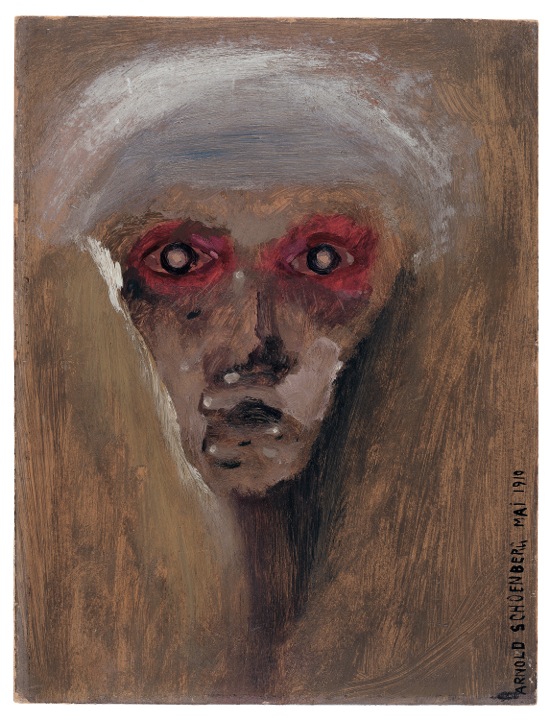Five reasons to go to the ''Schoenberg & Kandinsky'' exhibition at the Jewish Historical Museum. And two why you can omit a visit.
1. Prime
The exhibition is the first in the Netherlands to focus on Arnold Schoenberg (1874-1951) as an artist. Fifty paintings, drawings and designs by composer Arnold Schönberg are on show in the Netherlands for the first time. The music of this Austrian Jewish composer was first heard here over a century ago and has been performed regularly ever since. Schoenberg also visited the Netherlands several times. That he also painted is hardly known. Logical, as Schoenberg himself stated that he spent 90 per cent of his life on music. Yet painting was also an important way for him to express himself.
2. The person
The exhibition gives a clear picture of this man, who only followed his own compass and morals. Arnold Schoenberg was the founder of atonal music, and the world was not yet ready for that, given the scandals and boos his concerts raised at the beginning of the last century. Performances sometimes had to be stopped because his music was not understood at all. Probably in the years around 1910, though, this was the reason he threw himself more into painting. After he became friends with Kandinsky, the latter even invited him to the famous 1912 Der Blaue Reiter exhibition in Berlin. Schoenberg is said to have been contrarian. He himself saw it differently. He did not understand that he was not understood. He simply did what he had to do and expressed what was inside him. Whether that was through paintings or music didn't matter to him. They were both ways of expressing himself. With his music, he became a pathfinder of abstraction. Schoenberg was born to Jewish parents in Vienna in 1874. Judaism initially interested him little. Although circumcised according to Jewish tradition, he grew up in an assimilated family and later in life converted to Protestantism. Against his will, he came into contact with Judaism. To the outside world, he was still seen as a Jew, which is why he was not welcome in certain cities. Anti-Semitic remarks by Kandinsky were also the cause of the end of their friendship; they wrote their last letters in 1936. He fled the anti-Semitic climate in Austria and Germany and went to Paris in 1933. There he converted back to Judaism, with Marc Chagall as a witness. Later, he went to the United States via Spain. Here he continued to compose and teach until his death. His music also shows his commitment to the Jewish people, the Shoah and the state of Israel.
3. Kandinsky
The woodcuts on display are beautiful. Both abstract and figurative, but beautiful. The 1906 painting of his mistress, Gabriele Münter Bathing Louisa Rapallo is a small, warm and intimate canvas.
4. Multimedia experience
Music and art were equally important to Schoenberg. The museum lets visitors experience this through an audio tour. Standing near the paintings, you can listen to the music Schoenberg composed during the time he painted. You can also listen to music that inspired Kandinsky. A 13-minute film gives a good introduction to Schoenberg's life. The catalogue, ''Arnold Schoenberg. Life in Art and Music'' rounds it off. It is the first Dutch-language publication on the composer since the 1970s.
5. Schiele
Besides Mahler, Kokoschka, Kandinsky and Klimt, Egon Schiele was also a contemporary of Schoenberg. A year before his death, Schiele made an incisive portrait of Schoenberg. This loan from a private collection alone makes the exhibition worth a visit.
[su_heading]Reasons not to go:[/su_heading]
1. The title
With the title of the exhibition, the Jewish Historical Museum misleads visitors because it is actually mainly about Schoenberg. Apparently another marketing ploy to attract more visitors. Kandinsky simply lures more than Schoenberg alone would. The relationship, friendship and their kinship do come into play. The Jewish Historical Museum had to go to great lengths to borrow canvases by Kandinsky, as international museums hardly lend them. The canvases are usually part of the permanent exhibitions. Yet works by Kandinsky do hang there; the finest loans are from Boijmans Van Beuningen, and from a private one, fine woodcuts can be admired. The relationship between Kandinsky and Schönberg is also highlighted. Most importantly, after a concert by Schönberg (in Munich in 1911), Kandinsky knew he had to move in the abstract direction with his music. Through Schoenberg's music, he knew what it was all about. The kinship between colour and music is evident in Schoenberg's music and Kandinsky's paintings.

2. The paintings
With his music, Arnold Schoenberg became world-famous and was an innovator. His painting will not bring this fame. Nor are the paintings a reason for a diversion. For true Schoenberg fans, though, it will be interesting to see what else the man did. Even if what he painted cannot be called innovative, remarkable, nor shocking or beautiful. His canvases can be divided into landscapes and visions. The latter are special, though. They are glimpses he tries to capture. About 'Gaze' from 1910, he says: ''I do not look at people's faces, but at their eyes, just at their gaze. Hence I can depict a person's gaze.''
[su_service title="Good to know" icon="icon: check-square"]Jewish Historical Museum: ''Schoenberg & Kandinsky. Defiant in Art and Music''. Tm 16 March 2014. Catalogue: ''Schoenberg. Life in Art and Music". 19.95 euros. More info: www.jhm.nl[/su_service]